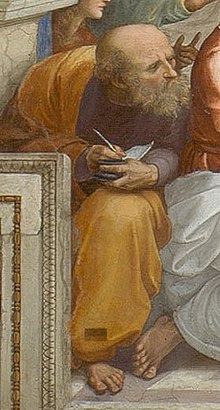
Back Anaximander Afrikaans أناكسيماندر Arabic اناكسيماندر ARZ Anaksimandr Azerbaijani Анаксімандр Byelorussian Анаксымандар BE-X-OLD Анаксимандър Bulgarian আনাক্সিমান্দ্রোস Bengali/Bangla Anaksimandar BS Anaximandre Catalan
Anaximander | |
|---|---|
 Raphael representing Anaximander (Roma, Museo Nazionale Romano). Probably Roman copy of an earlier Greek original. This is the only existing image of Anaximander from the ancient world. | |
| Born | c. 611 BC |
| Died | c. 546 BC |
| Era | Pre-Socratic philosophy |
| Region | Western Philosophy |
| School | Ionian Philosophy, Milesian school, Naturalism |
Main interests | Metaphysics, astronomy, geometry, geography |
Notable ideas | The apeiron is the arche Evolutionary view of living things[1][2] Earth floats unsupported Mechanical model of the sky Water of rain from evaporation |
Influences
| |
Influenced | |

Anaximander (/æˌnæksɪˈmændər/; Greek: Ἀναξίμανδρος Anaximandros; c. 610 – c. 546 BC) was a Pre-Socratic Greek philosopher who lived in Miletus,[3] a city of Ionia. He belonged to the Milesian school and learned the teachings of his master Thales. He succeeded him and became the second master of that school where he counted Anaximenes and Pythagoras amongst his pupils.[4]
Little of his life and work is known today. According to available historical documents, he is the first philosopher known to have written down his studies,[5] although only one fragment of his work remains. Fragmentary testimonies found in documents after his death provide a portrait of the man.
- ↑ DK fragments A 11 and A 30
- ↑ "Anaximander". Encyclopædia Britannica Online.
- ↑ "Anaximander" in Chambers's Encyclopædia. London: George Newnes, 1961, Vol. 1, p. 403.
- ↑ Guthrie W.K.C. 1962. A history of Greek philosophy. Vol 1: the earlier Presocratics and the Pythagoreans. Cambridge.
- ↑ Themistius, Oratio 36, § 317